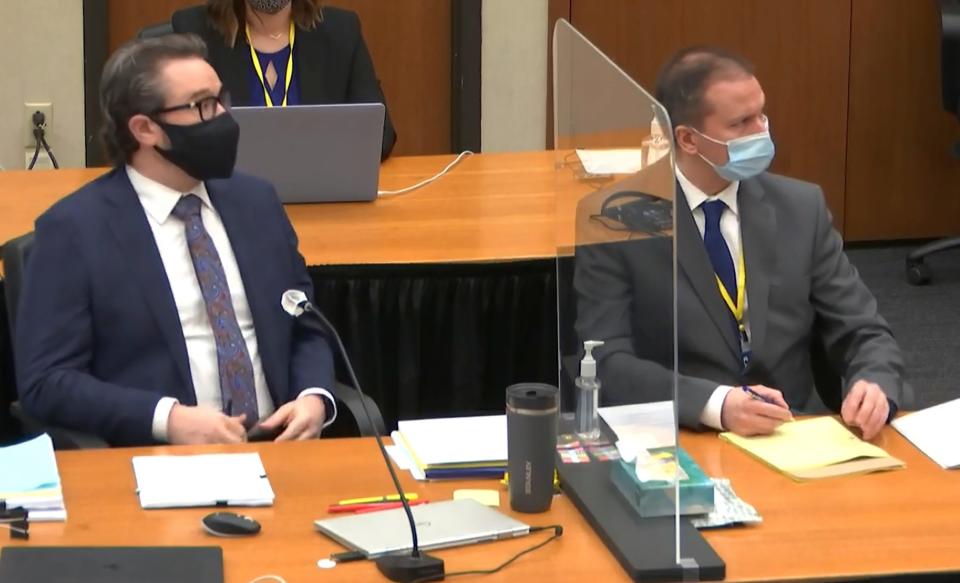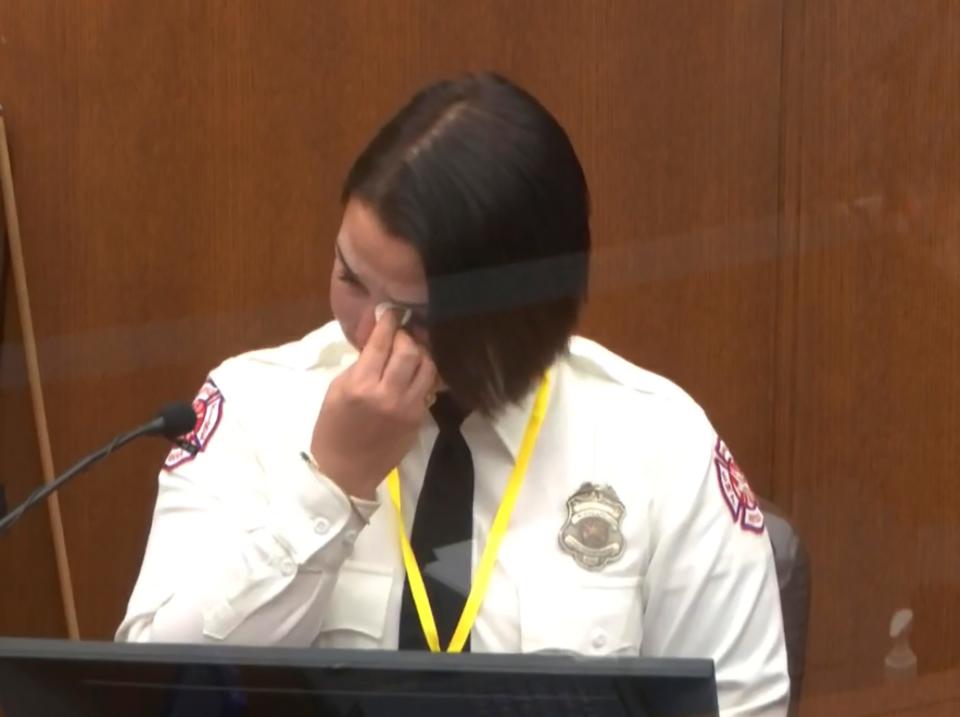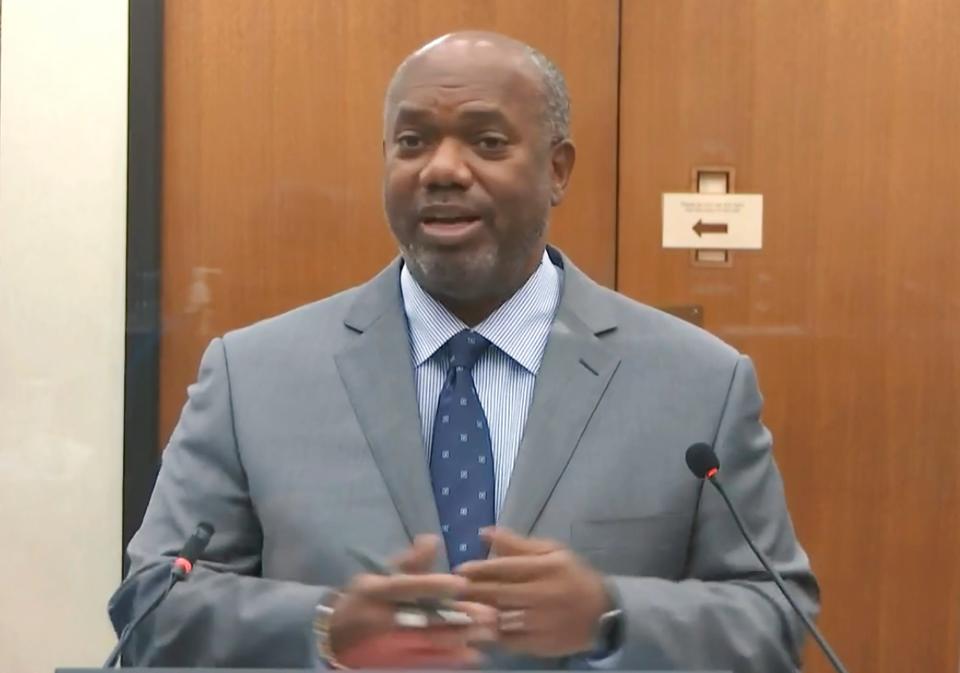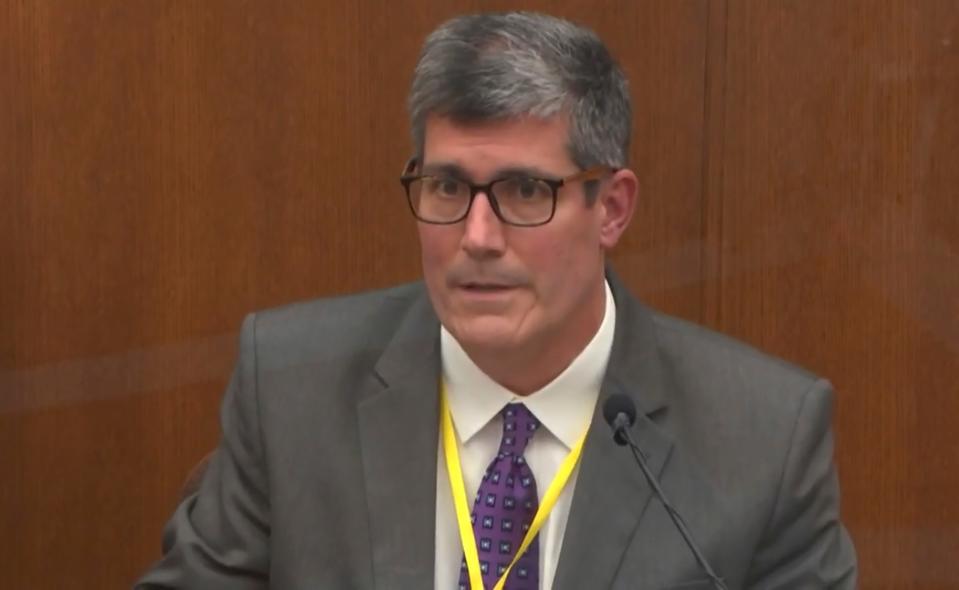Prosecution in Derek Chauvin trial rests after 11 days, 38 witnesses and dozens of video clips. Here are the highlights.
MINNEAPOLIS – After 11 days, 38 witnesses and dozens of video clips showing the minutes before and after George Floyd died under the knee of Derek Chauvin, the prosecution in the murder trial of the former police officer rested its case Tuesday.
Chauvin is charged with second-degree murder, third-degree murder and second-degree manslaughter in Floyd's death on May 25, 2020.
The prosecution, led by the Minnesota Attorney General's office, called to the stand eyewitnesses, Minneapolis police officers and paramedics, law enforcement experts and a range of medical experts in a bid to prove Floyd died because Chauvin pressed his knee into Chauvin's neck for more than nine minutes.
A bystander video was expected to be a key piece of evidence, but it was just one of several presented by prosecutors in an effort to make jurors feel as if they were there when Floyd died on the street.
Stay updated on the Derek Chauvin trial: Sign up for text messages of key updates
Derek Chauvin trial live:Defense witness says Chauvin's use of force against George Floyd was 'justified'
Some of the videos were shaky and close-up, with the sounds of Floyd gasping for air and the crowd shouting at Chauvin and three other officers. Others were silent, recorded from high above the intersection or neighboring businesses. One showed Floyd as he stood in Cup Foods, waiting to buy cigarettes with a $20 bill that a store clerk testified looked fake.
A key moment in the prosecution's case came when an expert on the physiology of breathing walked jurors through his conclusion that Floyd had been slowly suffocated. Dr. Martin Tobin said the way Floyd was restrained — handcuffed behind his back, face-down on the ground, with a knee on his neck — prevented him from breathing properly.
The effect of the officers' actions and Floyd's position was almost "as if a surgeon had gone in and removed the (left) lung," Tobin said, as jurors turned toward him and took notes on the testimony. The jurors are spaced out in the courtroom, sitting at individual desks.
The defense, meanwhile, has argued Floyd died from underlying medical conditions and the drugs in his system. Floyd's high blood pressure, coronary artery disease, and ingestion of methamphetamine and fentanyl, together with the struggle with police, led his heart to stop, the defense argued.
Prosecutors tried to head off those arguments by asking witnesses to testify about Floyd's underlying health issues and his struggle with opioids.
Derek Chauvin has been in court for weeks now, starting with jury selection last month. Wearing a face mask and a suit, he has sat up straight and has appeared to take notes on a yellow legal pad during testimony.
Live coverage of Chauvin trial: Prosecution rests its case after 11 days; defense calls first witnesses

Eyewitnesses described watching Floyd die: 'Totally distressed' and 'helpless'
The prosecution opened its case by calling bystanders who became emotional as they recounted their attempts to intervene in Floyd's death. Among them: the teenager who recorded a video shared worldwide on social media, her 9-year-old cousin, and an off-duty Minneapolis firefighter who pleaded with officers to allow her to administer first aid to Floyd.
Floyd's girlfriend, Courteney Ross, gave jurors intimate glimpses of Floyd's life – how they first met and where they first kissed.
Several of the witnesses said they live with the guilt of not having done more to save Floyd.

Firefighter Genevieve Hansen, 27, broke down in tears on the stand as she testified about being prevented from helping Floyd. Trained as an EMT, Hansen was on a walk when she came upon the officers restraining Floyd on the ground. She can be heard on video begging officers to check Floyd's pulse. In court, she described feeling "totally distressed" and "helpless" that the police wouldn't let her provide medical attention.
Darnella Frazier, 18, who recorded the viral video, told prosecutor Jerry Blackwell that when she looked at Floyd, she saw her Black relatives and friends.
"When I look at George Floyd, I look at my dad, I look at my brothers, I look at my cousins, my uncles," Frazier said. She said she has stayed up some nights "apologizing and apologizing to George Floyd for not doing more and not physically interacting and not saving his life."
But, she said, "it’s not what I should have done. It’s what he (Chauvin) should have done."

Minneapolis police officials, national experts said Chauvin's actions were out of line
Prosecutors aimed to show that Floyd broke Minneapolis Police Department policy and nationally accepted policing standards.
They argued Chauvin violated policies to de-escalate the situation and adjust how much force he was using based on Floyd's behavior. They presented evidence that Chauvin's use of force violated the law by not abiding guidelines laid out by the U.S. Supreme Court.
Opinion: Blue wall of silence crumbling. Police chief, others, bring landmark moment
Minneapolis Police Chief Medaria Arradondo said Chauvin's restraint "absolutely" violated department policy and went against "our ethics and our values." Lt. Richard Zimmerman, head of the department's homicide unit, said Chauvin's use of force was "totally unnecessary" and "uncalled for."
Lt. Johnny Mercil, a use-of-force expert who taught a use of force training class Chauvin attended, said the department did not train officers to use the knee-on-neck restraint.
Defense argues Floyd, crowd posed a threat to officers
On cross examination, lead defense attorney Eric Nelson solicited testimony from state witnesses to suggest officers were threatened and distracted by an angry mob of bystanders, which he argued made it too difficult for officers to render medical aid or de-escalate the situation any more than the officers did when they chose not to use a hobble restraint on Floyd.
Nelson asked several of the bystanders whether they were "upset" by what they saw that day, at times quoting vulgarities heard in the videos and pacing in the courtroom to make his point. On cross-examination of the paramedics, Nelson highlighted their decision to move Floyd away from the scene, away from the crowd, before they tried to revive him.

Nelson also asked witnesses whether it's possible someone who has been rendered unconscious could possibly reawaken and become combative, an attempt to show Floyd continued to be a threat to officers even after he was handcuffed and unconscious on the ground. Several witnesses agreed that could happen.
Nelson also used a short clip of bystander and body-cam videos, played side-by-side, to argue Chauvin's knee was not Floyd's neck, but rather on his shoulder blade – an argument he will likely expand on in the coming days.
Prosecution says Chauvin betrayed 'duty of care'
The prosecution argued Chauvin not only used excessive force – but that he also failed to carry out his duty to provide basic care when Floyd was in medical distress and became unresponsive.
After another officer told Chauvin that Floyd had no pulse, Chauvin continued to kneel on Floyd for 2½ minutes instead of attempting CPR or chest compressions to revive him, witnesses testified.
Two Minneapolis police employees, including the EMT who leads the department's emergency medical response training, told jurors that officers are trained to call for an ambulance and provide medical aid in life-threatening situations.
"If it’s a critical situation, you have to do both" – call for an ambulance and provide first aid such as CPR, said Minneapolis police officer Nicole Mackenzie, who conducts first aid education for officers.
Derek Smith, a paramedic with Hennepin County EMS who responded to the scene that day, told jurors he thoughts Floyd was dead when he arrived. "I told my partner, I think he's dead, and I want to move this out of here," Smith said.
The emergency room doctor who tried to resuscitate Floyd at Hennepin County Medical Center told jurors Floyd died from low oxygen – not a heart attack or overdose.

Several medical experts testified that, based on a review of documents and videos, they believed Floyd died of asphyxia, or low oxgyen, due to how he was restrained by officers. Dr. Martin Tobin, the expert on the physiology of breathing, explained why he believed the officers' actions slowly suffocated Floyd.
"It's like the left side is in a vise. It's totally pushed in, squeezed in from the street at the bottom, and then from the way the handcuffs are manipulated," Tobin said. "That totally interferes with central features of how we breathe."
He said, "A healthy person subjected to what Mr. Floyd was subjected to would have died as a result."
Medical examiner testified health conditions, drugs contributed to Floyd's death
Nelson turned state's witness Hennepin County medical examiner Dr. Andrew Baker into a key defense witness. On Friday, Baker emphasized that the direct cause of death from his autopsy of Floyd remained unchanged: Floyd died from "cardiopulmonary arrest" as a result of him being subdued, restrained and having his neck compressed by law enforcement.
Nelson highlighted Baker's view that Floyd's heart disease, history of hypertension and the drugs in his system "contributed" to his death, evidenced by a heart that "weighed more than it should" and coronary arteries that were significantly narrowed, according to Baker.
"It was the stress of that interaction that tipped him over the edge, given his underlying heart disease and its toxicology status," Baker said.
He told jurors that if Floyd had been found dead in his locked residence with no evidence of trauma, he would've concluded Floyd died of an overdose.

The prosecution appeared to anticipate the difficulty of Baker's testimony. They called to the stand former county forensic pathologist Dr. Lindsey Thomas before Baker.
Thomas said she has conducted roughly 5,000 autopsies over her career and helped train Baker. She went further than Baker did, telling jurors she believed the actual "mechanism" that caused Floyd to stop breathing and his heart to stop beating was low oxygen, or asphyxia.
She said there no evidence Floyd would have died that last May if he had not interacted with the officers.
Family member closes testimony
The prosecution's case ended much like it began: with tears.
Philonise Floyd, 39, told jurors stories about growing up with his "big brother" as prosecutors showed jurors photos of George taken throughout his life: a baby nestled on his mother’s chest, a teen leaning over a textbook, a basketball player on the South Florida Community College basketball team, and a father holding up his daughter.
The younger brother choked up seeing the image of George – nicknamed "Perry" after his father – and his mother. "I miss both of them," he said.

Philonise Floyd testified as a "spark of life" witness to give jurors a better sense of who George was. A Minnesota Supreme Court ruling allows prosecutors to humanize deceased subjects.
Philonise Floyd said his brother "was so much a leader to us in the household." He was born in Fayetteville, North Carolina, and the family moved to Houston when they were young. The brothers have two older sisters. George Floyd was born after them, then Philonise and Rodney.
"He would always make sure we had our clothes for school. He made sure we all were going to be to school on time," Philonise Floyd said. George couldn’t cook — he "couldn’t boil water" — but, Philonise Floyd said, he made "the best banana mayonnaise sandwiches."
The defense began calling witnesses Tuesday. The judge said he expected closing arguments to happen Monday.
This article originally appeared on USA TODAY: Derek Chauvin trial: Prosecutor's case in George Floyd death explained

 money
money 